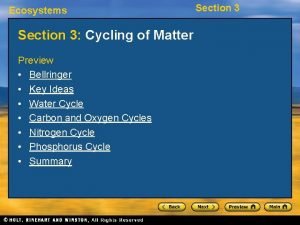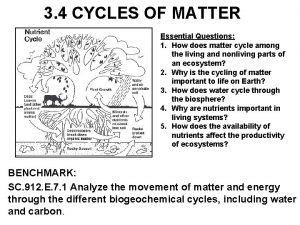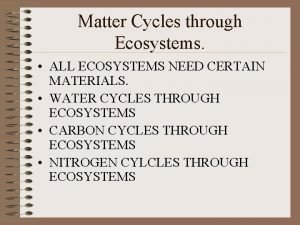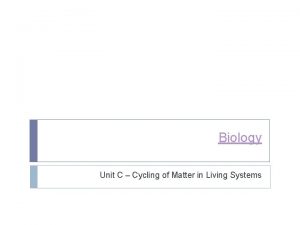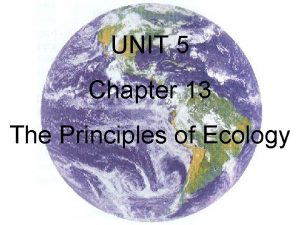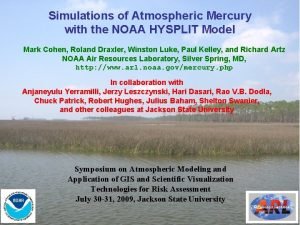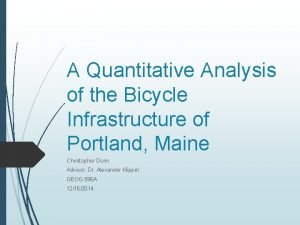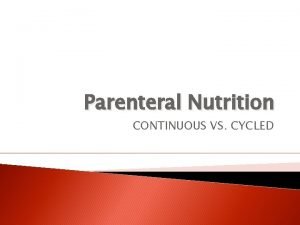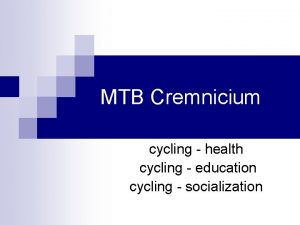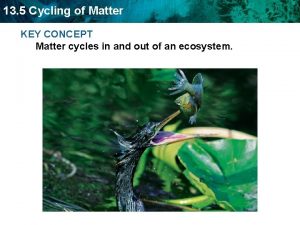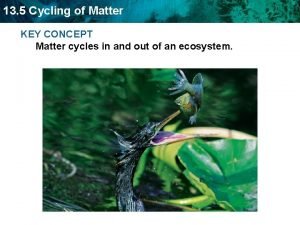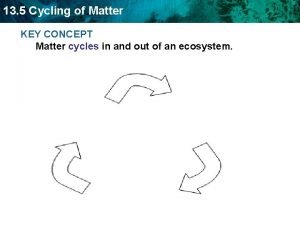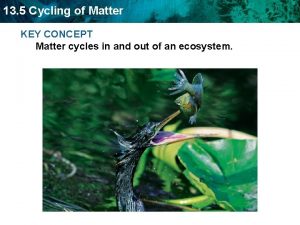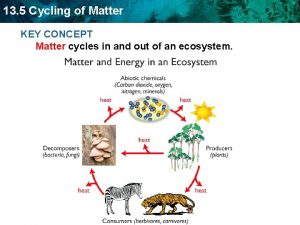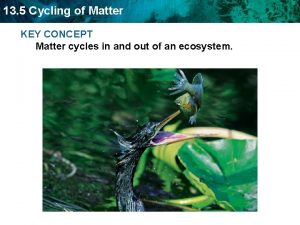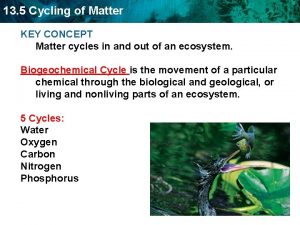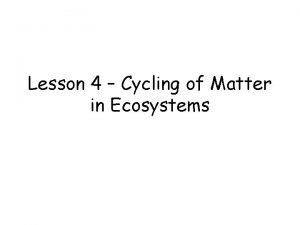13 5 Cycling of Matter KEY CONCEPT Matter













- Slides: 13

13. 5 Cycling of Matter KEY CONCEPT Matter cycles in and out of an ecosystem.

13. 5 Cycling of Matter Water cycles through the environment. • The hydrologic, or water, cycle is the circular pathway of water on Earth. • Organisms all have bodies made mostly of water. precipitation condensation transpiration lake surface runoff evaporation water storage in ocean groundwater see pag e

13. 5 Cycling of Matter Elements essential for life also cycle through ecosystems. • A biogeochemical cycle is the movement of a particular chemical through the biological and geological parts of an ecosystem. • The main processes involved in the oxygen cycle are photosynthesis and respiration.

13. 5 Cycling of Matter • Oxygen cycles indirectly through an ecosystem by the cycling of other nutrients. oxygen photosynthesis respiration carbon dioxide

13. 5 Cycling of Matter • Carbon is the building block of life. – The carbon cycle moves carbon from the atmosphere, through the food web, and returns to the atmosphere. – Carbon is emitted by the burning of fossil fuels. – Some carbon is stored for long periods of time in areas called carbon sinks. carbon dioxide in air combustion respiration photosynthesis respiration decomposition of organisms fossil fuels photosynthesis carbon dioxide dissolved in water

13. 5 Cycling of Matter • The nitrogen cycle mostly takes place underground. – Some bacteria convert gaseous nitrogen into ammonia through a process called nitrogen fixation. – Some nitrogen-fixing bacteria live in nodules on the nitrogen in atmosphere roots of plants; animals others live freely in the soil. plant nitrogen-fixing bacteria in decomposers roots ammonification nitrogen-fixing ammonium bacteria in soil nitrifying bacteria nitrates nitrifying bacteria nitrites denitrifying bacteria

13. 5 Cycling of Matter – Ammonia released into the soil is transformed into ammonium. – Nitrifying bacteria change the ammonium into nitrate. – Nitrogen moves through the food web and returns nitrogen in atmosphere to the soil during animals decomposition. plant nitrogen-fixing bacteria in decomposers roots ammonification nitrogen-fixing ammonium bacteria in soil nitrifying bacteria nitrates nitrifying bacteria nitrites denitrifying bacteria

13. 5 Cycling of Matter • The phosphorus cycle takes place at and below ground level. – Phosphate is released by the weathering of rocks. – Phosphorus moves through the food web and returns to the soil during decomposition. rain geologic uplifting – Phosphorus leaches into groundwater weathering of phosphate from rocks from the soil and runoff plants is locked in sediments. animalsphosphate in solution in soil – Both mining and leaching agriculture add sedimentation phosphorus into decomposers forms new rocks the environment.

13. 5 Cycling of Matter The water cycle, in which water moves from the atmosphere, to the surface, below ground and back is called A. B. C. D. Biogeochemical cycle Oxygen cycle Hydrologic cycle Nitrogen cycle

13. 5 Cycling of Matter Which two biogeochemical cycles depend directly on photosynthesis? A. B. C. D. Hydrologic cycle and oxygen cycle Carbon cycle and phosphorous cycle Nitrogen cycle and phosphorous cycle Oxygen cycle and carbon cycle

13. 5 Cycling of Matter Fossil fuels are part of which of the following cycles? A. B. C. D. Oxygen Carbon Nitrogen Phosphorous

13. 5 Cycling of Matter What happens during the process of nitrogen fixation? A. B. C. D. Bacteria changes ammonium into nitrate Bacteria grows on nodules on plant roots Bacteria absorb ammonia and excrete ammonium Bacteria convert gaseous nitrogen into ammonia

13. 5 Cycling of Matter Where does most of the phosphorous cycle take place? A. B. C. D. In the atmosphere At and below ground level On fungi near plant roots Close to rocky terrain
 Section 3 cycling of matter answer key
Section 3 cycling of matter answer key Chapter 2 section 3 cycling of matter answer key
Chapter 2 section 3 cycling of matter answer key Cycling of matter in an ecosystem
Cycling of matter in an ecosystem Principles of ecology section 3 cycling of matter
Principles of ecology section 3 cycling of matter Matter cycling in ecosystems
Matter cycling in ecosystems Principles of ecology section 3 cycling of matter
Principles of ecology section 3 cycling of matter Cycling of matter definition biology
Cycling of matter definition biology Chapter 2 section 1 classifying matter answer key
Chapter 2 section 1 classifying matter answer key Minerals concept map
Minerals concept map Key concept builder lesson 1 what are waves answer key
Key concept builder lesson 1 what are waves answer key A bird stalks kills then eats
A bird stalks kills then eats Cycling swanier
Cycling swanier Quantitative research about cycling
Quantitative research about cycling Continuous parenteral nutrition
Continuous parenteral nutrition
